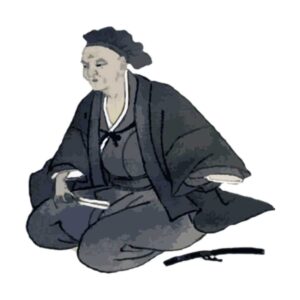
Founder of Chanoyu. Murata jyukou Murata Jukou
Born in 1422 (Oei 29).
He is said to have gone by the names Dokushiken and Nansei, and also to have called himself Korakuan Kyushinboji.
His childhood name was Shigekichi.
He was the son of Murata Mokuichi Kensho of Nara.
At the age of 11, he became a monk at Shomyoji Temple under Kofukuji Temple, but at the age of 20, he decided not to become a monk and drifted around, living as a Zen monk at the Daitokuji Shinjuan Temple in Nara.
His Zen master was the famous Ikkyu Soujun, who gave him the ink seki of Kakureno-Kakumago.
Originally, Shuko was close to Noami, a fellow student of the Shogunate, and learned the tea ceremony and the method of Chinese object recognition from Noami. I have told you all the details of the secret teachings and oral traditions of Shukoh.
Also, I will tell you about the details of the Buddhist teachings in the tea ceremony.
In addition, he also explained the details of the two aspects of the tea ceremony in the Buddhist teachings.
As stated in Nanpōroku, Shūkō’s tea ceremony style gradually developed a more spiritual orientation, moving away from the simple and superficial traditional Shōin style of tea ceremony decorated with Chinese objects, as described in the following sentence given by Shūkō to his disciple Harima Furuichi: “The most important thing in this way is to be careful to avoid blurring the border between the Japanese and Chinese traditions. -You must be very careful.
It is outrageous for a novice to take a Bizen or Shigaraki object and make it cool down, but it is only interesting if you have good tools, know what they taste like, and make it cool down based on the grounding of your heart. The philosophy of Shuko in the tea ceremony is known from the spirituality of the renga master’s pursuit of the traditional tea ceremony for the common people in the remote areas of the capital, and from the Zen spirit of Naoto, who was influenced by the tea ceremony of Ikkyu. He also added the Shoin-tea method, which he learned from Noami, to the traditional tea ceremony, and here he renewed chanoyu as a “way” of tea ceremony.
In this sense, Rikyu himself later said, “The Law is from Shao’ou and the Way is from Shukoh,” and Shukoh came to be called the founder of tea ceremony and the founder of the tea ceremony.
He also recognized the deep and cool beauty of Shukoh celadon porcelain and ash-covered tenmoku, etc., which had a strong inclination toward bitterness, and treated Korai tea bowls in the same way as tenmoku, and discovered and adopted the beauty of Bizen, Shigaraki, and other Japanese ceramics.
He also discovered and adopted the beauty of Japanese objects such as Bizen and Shigaraki, although he also possessed many Chinese objects.
Among them, he bequeathed to his successor Soju his respect for Tugo’s ink seki, Toutoukin tea caddy, and Xu Xi’s egret paintings, which symbolize the spirit of his own sukkyoku.
While living in Kyoto, he established a teahouse on the west side of the Rokujo Horikawa River, and it is said that Yoshimasa gave it the name “Shuko-an-shu” (master of the Shuko-an teahouse).
He had many disciples in Kyoto, Sakai, and Nara, including Matsumoto Shuho, Shino Michimi, Furuichi Sumitane, Awataguchi Zenpo, and Torii Hidetoshi.
He died on May 15, 1502, at the age of 81.



